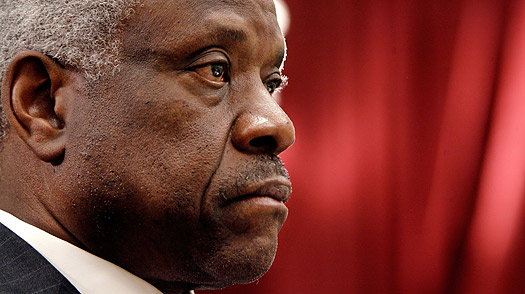
Supreme Court Justice Clarence Thomas
It has become fashionable for Supreme Court nominees and sometimes the Justices themselves to deflect controversy and play down their own importance by suggesting judicial decision-making involves nothing more than the simple application of clear, undisputed rules. Perhaps with Obama's selection of a woman, we won't be subjected to the baseball metaphor that Chief Justice John Roberts has used, but however the idea is couched, it's pure bunk. There is no rulebook for constitutional interpretation. In trying to give meaning to inherently elastic constitutional concepts like "equal protection of the laws" and due process, and in interpreting federal statutes that are often less than precise, Supreme Court Justices inevitably make subjective value judgments that are colored by their individual views about right and wrong, fair and unfair, wise and unwise.
In voting against confirming John Roberts, then Senator Obama explained that he was opposing the conservative Roberts because of how he would decide the slim "5%" of cases in which the law really is ambiguous and a Justice's values will inevitably shape his or her views. Our law-professor President got the concept right but the percentage wrong. Cases rarely reach the Supreme Court level when the right answer is clear. Most of the time, the Supreme Court hears cases only after lower federal courts have reached conflicting answers on vexing legal questions.
In short, there is a reason that Justice Harry Blackmun, a man whose grandfathers had fought for the Union in the Civil War and who idolized Abraham Lincoln, opposed the states' rights movement and was a passionate liberal voice on issues of race. There is a reason that Ruth Bader Ginsburg, a pioneer of the fight for women's legal equality, takes an expansive view of the equal-protection clause. There is a reason that Roberts, who came of age as a foot soldier in the Reagan Revolution, has a voting record that matches the old Reagan agenda. And there is a reason that Clarence Thomas, who grew up resenting the racial preferences that took him up the educational ladder to Yale Law School, reads the Constitution as imposing absolute colorblindness on government actors.
Conscientious judges understand that the law is much more than a reflection of their own personal preferences. But in the hard cases, the political cases, the cases tinged with moral judgment, where constitutional language and history provide no single irrefutable answer, a judge's formative experience matters — family, geography, mentors and heroes — they cleave liberal from conservative and ineluctably insinuate themselves into the law.